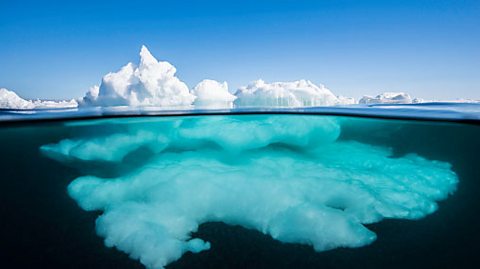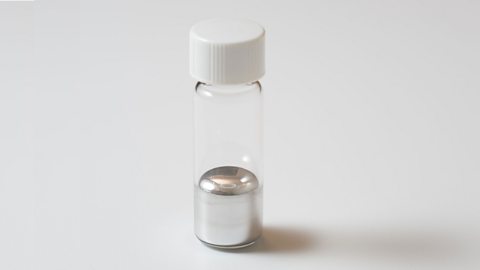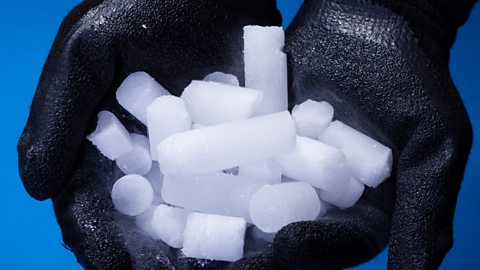Key points
The densityAll substances are made of particles. Density is a measure of how close together particles are. Closely packed particles have a higher density than particles that are spread out. of an object or substance is its massA measure of the amount of matter an object is made out of. Mass is measured in kilograms (kg). divided by its volumeThe amount of space an object occupies, usually measured in m³ or cm³..
The units of density depend on the units used for mass and volume. The most commonly used units are grams per cubic centimetre (g/cm³) or kilograms per cubic metre (kg/m³).
The density of a substance depends both on the mass of the particlesAll substances are made of particles. Particles could be atoms, molecules or ions., and how closely spaced they are. This means that density changes when substances change state, and when they are heated or cooled.
Video - Densities of the states
These balloons are the same size, but this one is filled with water instead of air and is much heavier.
I know which I’d prefer to try and catch! And that’s because water and air have different densities.
You can think of density as how heavy something is for its size.And you can calculate it by taking the mass - this is five hundred grams - and dividing it by the volume.
You can find the volume of an irregular shaped object by submerging it in water and measuring how much this level changes.
This has gone up by five hundred cubic centimetres, so that’s the volume.
So density is mass divided by volume, five hundred grams divided by five hundred cubic centimetres, giving one gram per cubic centimetre.
But this air-filled balloon has a much lower density of about zero point zero zero one gram per cubic centimetre. The difference is mostly due to the fact that air is a gas and the water is a liquid, because density depends a lot on the state of matter.
In a solid, the particles are tightly packed, so you can get a lot in a given space. Solids have a high density.
In liquids, the particles can move around more freely, so they slide over each other with some gaps between them. Liquids typically have a lower density than solids.
In gases the particles are far apart, moving quickly in random directions with a lot of empty space between them. So they have the lowest density of all.
Interestingly, water is an exception to this rule.
Solid ice is less dense than liquid water, because the particles must pack together more closely in the liquid.
That’s why ice floats.
But even substances in the same state can have different densities, depending on the mass of the atoms that make them up.
So a balloon filled with helium is less dense than one filled with air, because helium atoms are lighter than the atoms in air. So a helium balloon floats!
Can you answer these questions based on the video?
Why does a balloon filled with helium float and one filled with water doesn’t?
Why do solids generally have high densities?
Water has a higher density than air.
The particles in a solid are tightly packed, so a lot of particles fit into a given space. This means solids have relatively high densities.
Calculating density
The iron cube is much heavier than the wooden cube, even though they are both the same size. This is because the iron cube has a much higher density. The cube of polystyrene is the same size but is lighter than both because it has an even lower density.
Objects with a higher density feel heavier for their size because more matter is packed into the same space.
Density can be measured in lots of different units, but the most commonly used units are grams per cubic centimetre (g/cm³) and kilograms per cubic metre (kg/m³).
The density of an object or a substance is its mass, divided by its volume. We use the formula:
\(density = mass ÷ volume\)
to calculate the density of an object or substance.
For example, the iron cube has a volume of 8 cm³ and a mass of 63 g, so:
\(density = mass ÷ volume\)
\(density = 63 ÷ 8\)
\(density = 7.9 g/cm³\)
The wooden cube has a volume of 8 cm³ and a mass of 4 g, so:
\(density = mass ÷ volume\)
\(density = 4 ÷ 8\)
\(density = 0.5 g/cm³\)
A block of polystyrene packing material has a volume of 200 cm³ and a mass of 7g. What is the density of the polystyrene?
\(density = mass ÷ volume\)
\(density = 7 ÷ 200\)
\(density = 0.035 g/cm³\)
The density of the block of polystyrene is 0.035 g/cm³.

Did you know?
A typical neutron star (an object left over when some large stars stop shining) contains more mass than the Sun but is only around 20km across, which results in an extremely high density.
A teaspoon of material from a neutron star would have a mass of around 5 billion tonnes.

Measuring density

The two quantities you need to measure in order to work out the density of an object are massA measure of the amount of matter an object is made out of. Mass is measured in kilograms (kg). and volumeThe amount of space an object occupies, usually measured in m³ or cm³..
To measure mass place the object on a top pan balance and read off the mass.

Finding the volume of a regular shape
Finding the volume of a regular shape can also be done by direct measurement. For example, for a cuboid, measure the sides and multiply length by width by height:
\(volume = length \times width\times height\)
\(v = l \times w \times h\)
Finding the volume of an irregular shape
To find the volume of an irregular object that cannot be measured with a ruler, use a eureka can.
A eureka can is filled with water and when you place an object in the water, the water overflows. The eureka can has a spout so that you can capture the overflowing water and measure its volume.
The volume of displaceTo move something out of the way by taking its place.water is the same as the volume of the object.

Once you have measured the mass and volume, you can calculate the density using the same equation:\(Density = \frac{mass}{volume}\)
Densities of the states

Different substances have different densities. For example:
solid steel has a density of 7.82 g/cm³
liquid water has a density of 1.00 g/cm³
air (in its gaseous form) has a density of 0.0012 g/cm³
The solidOne of the three states of matter. Solids, like ice or concrete, have a fixed shape and cannot be compressed easily. (steel) has the highest density, the gasOne of the three states of matter. Gases, like oxygen or helium, do not have a fixed shape and can expand to fill their container. (air) has the lowest density, and the density of the liquidOne of the three states of matter. Liquids, like water or oil, do not have a fixed shape and can flow. (water) is in between.
The density of a substance depends both on the mass of the particlesAll substances are made of particles. Particles could be atoms, molecules or ions., and how closely spaced they are.

Solids
The particles in solids are very close together. They are tightly packed, so solids have a high density.
Liquids
The particles in liquids are close together. Although they are randomly arranged, they are still tightly packed, giving liquids high densities. The density of a substance as a liquid is usually only slightly less than its density as a solid. For example:
the density of solid aluminium is 2.72 g/cm³
the density of liquid aluminium is 2.38 g/cm³
This means that liquid aluminium floats on top of solid aluminium.
Water is different from most substances. It is less dense as a solid than as a liquid, because its particles move apart slightly on freezing. This is why ice cubes and icebergs float on liquid water.
Gases
The particles in gases are very far apart, so gases have a very low density.

Did you know?
Some liquids have a higher density than solids. For example, wood is a solid but has a lower density than water, which is why wood generally floats on top of water.
Liquid mercury has a very high density of 13.5 g/cm³ which is a higher density than steel or lead.

Expanding and contracting
Expanding
As an object or substance gets hotter, its particlesAll substances are made of particles. Particles could be atoms, molecules or ions. vibrate more. The increase in vibration means they push each other away - the more vibration there is, the bigger the distance between the particles.
More distance between each particle means that the substance will now take up more space - it has expandWhen the volume of a substance increases..
Contracting
The expanding effect happens for solids and liquids and can be reversed by cooling. The particle vibrations get smaller so the distance between particles gets less. The substance contractWhen the volume of a substance decreases..
Changing density in an expanding object
When an object expands, it doesn’t gain any particles. Its mass remains the same although its volume increases. This means the object has a lower density. In other words, the object has the same mass in a bigger volume.
Changing density in a contracting object
When an object contracts, it has the same mass in a smaller volume so density increases.

Did you know?
Bridges and railway tracks are built with small gaps between sections to allow for expansion in the summer. Without these gaps, the structures would expand and bend out of shape as they warm up.

Test your knowledge
Quiz - Multiple choice
GCSE exam dates 2025
Find out everything you need to know about the 2025 GCSE exams including dates, timetables and changes to exams to get your revision in shape.

More on Solids, liquids and gases
Find out more by working through a topic
- count1 of 4

- count2 of 4

- count3 of 4
